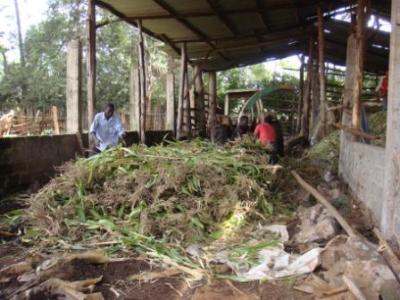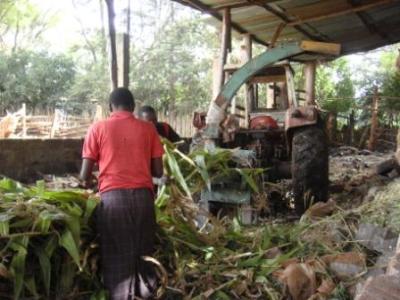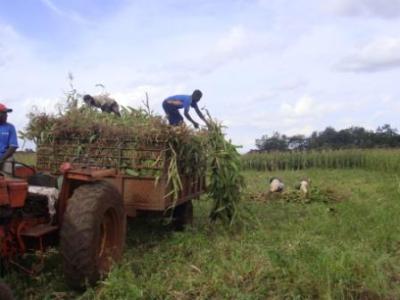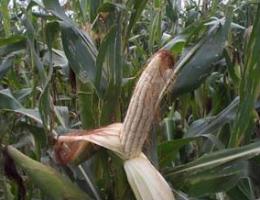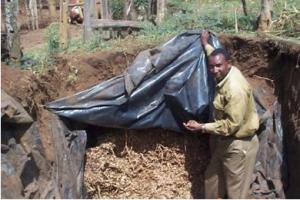Silage is the material produced by controlled fermentation, under anaerobic conditions, of chopped crop residues or forages with high moisture contents.
Silage is produced by the activities of naturally-occurring bacteria that convert some of the plant sugars into organic acids that preserve nutritional qualities.
Ideal characteristics of material used in silage making:
- Moisture content of 60-70%.
- pH below 4.2 for wet crops and below 4.8 for wilted silage.
Species of grass used:
- Napier grass
- Sorghum
- Maize
- Sugarcane tops
Advantages of Silage:
- Helps ease feed shortages during dry seasons.
Making silage
Feeding a forage chopper with forage
Harvesting for silage
How to make silage
- The crop should be ready to harvest: The seed of forage sorghum or maize should be soft but not milky when you squeeze it open.
- Napier grass (pennisetum) needs to be about a metre high (up to a man's waist).
- Legumes should have young pods which are not dry.
- If it has been raining and the forage is wet, or if the forage seems immature (the seed is very milky) then it is best to harvest it and leave it in the sun for a few hours to wilt (too much water in the forage can spoil the silage).
- The chopping and bagging area or silage pit must be clean and ready for the forage.
- Ensure proper compaction whether pit or bag silage is being made
- Seal the silage material and make sure the silo is air tight. Silage is formed through anaerobic fermentation by microorganisms.
- Carefully and step by step open a small portion of the silage when need arises for feeding and seal the remaining silage immediately after the removal.
Common method of silage making are through use of:
- Trench/Pit silos
- Plastic/Bag silos
A trench silo is built underground or semi-underground. A tractor or heavy loads are used to compact the material within the silo. Thereafter the silo is covered with a plastic sheet, weighed down with soil. This help maintain anaerobic conditions.
For plastic silos:
- Harvested fodder is chopped into 1'' lengths, mixed with molasses diluted in water (1:2)
- The mixture is then packed into a polythene tubing
- When the tube is filled, both ends are tightly tied
- The bag is then placed in an airtight container for the fermentation to occur.
The advantage of plastic silos is that they are low cost and can be moved easily. The quality of silage obtained, with maximized nutrient preservation, depends on the quality of the fodder used, the ensiling process and use of molasses. For example, Napier grass should be ensiled when 1 meter in length (101 days after planting). Properly ensiled material can store up to one year without losing quality.
Pit silage
Maize cob
Step 1. The crop should be ready to harvest: The seed of forage sorghum or maize to be soft but not milky when you squeeze it open.
Step 2. Napier grass (pennisetum) needs to be about a metre high (up to a man's waist).
Step 3.If there are legumes growing between the crop or bana grass, make sure the legumes have young pods which are not dry.
Step 4. If it has been raining and the forage is wet, or if the forage seems immature (the seed is very milky) then it is best to harvest it and leave it in the sun for a few hours to wilt (too much water in the forage can spoil the silage).
Chopping and bagging of silage materia
Step 5. The chopping and bagging area or silage pit must be clean and ready for the forage. If possible, a big piece of plastic should be spread out as shown below.
Step 6. Ensure proper compaction whether pit or bag silage is being made.
Sorghum silage made in a pit by smallholder dairy farmer
Sorghum silage made in a pit by smallholder dairy farmer
Step 7. Seal the silage material by ensuring no air can penetrate. Silage is formed through anaerobic fermentation by microorganisms.
Step 8. Carefully and step by step open a small portion of the silage when need arises for feeding and seal the remaining silage immediately after the removal.

